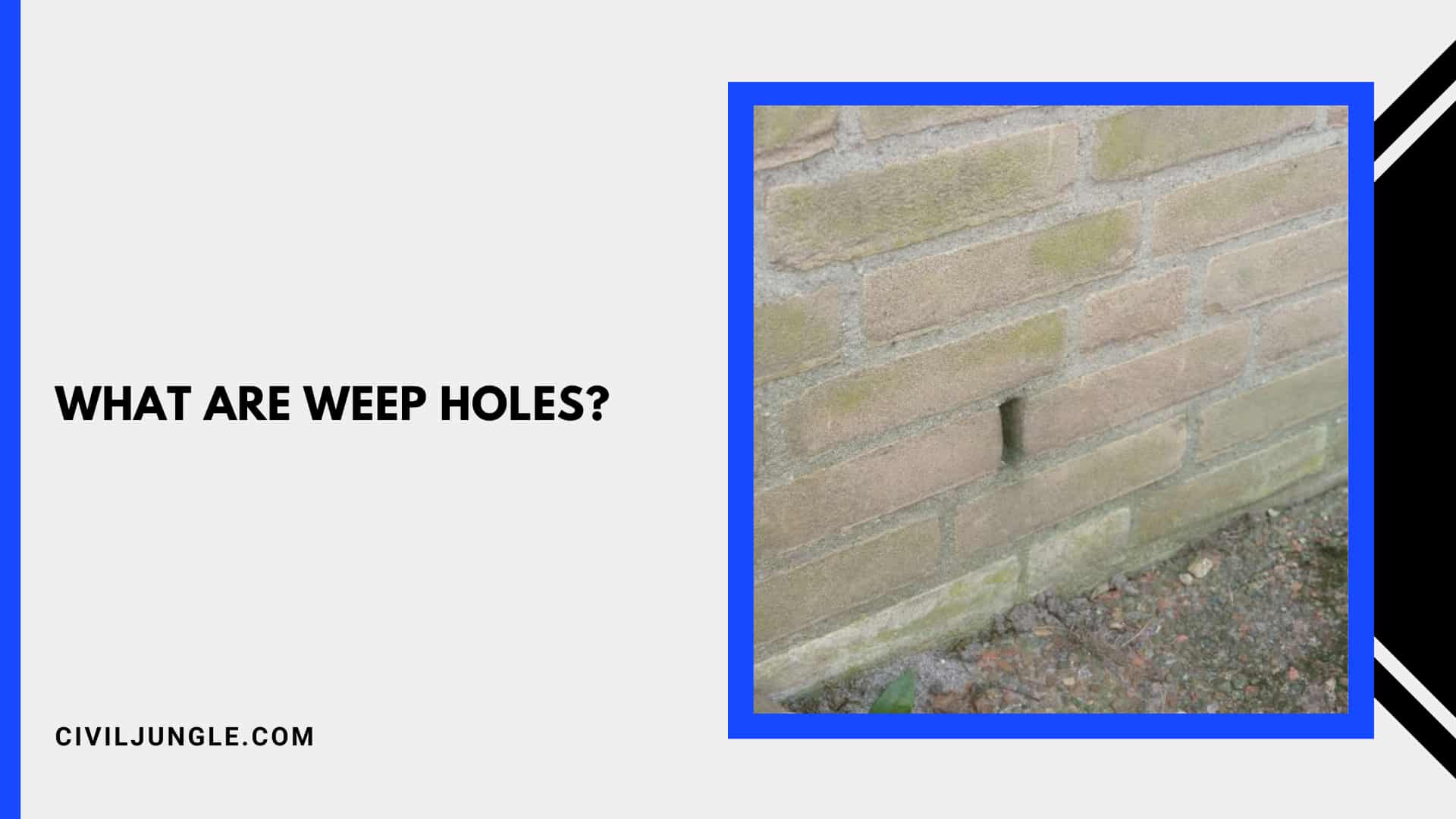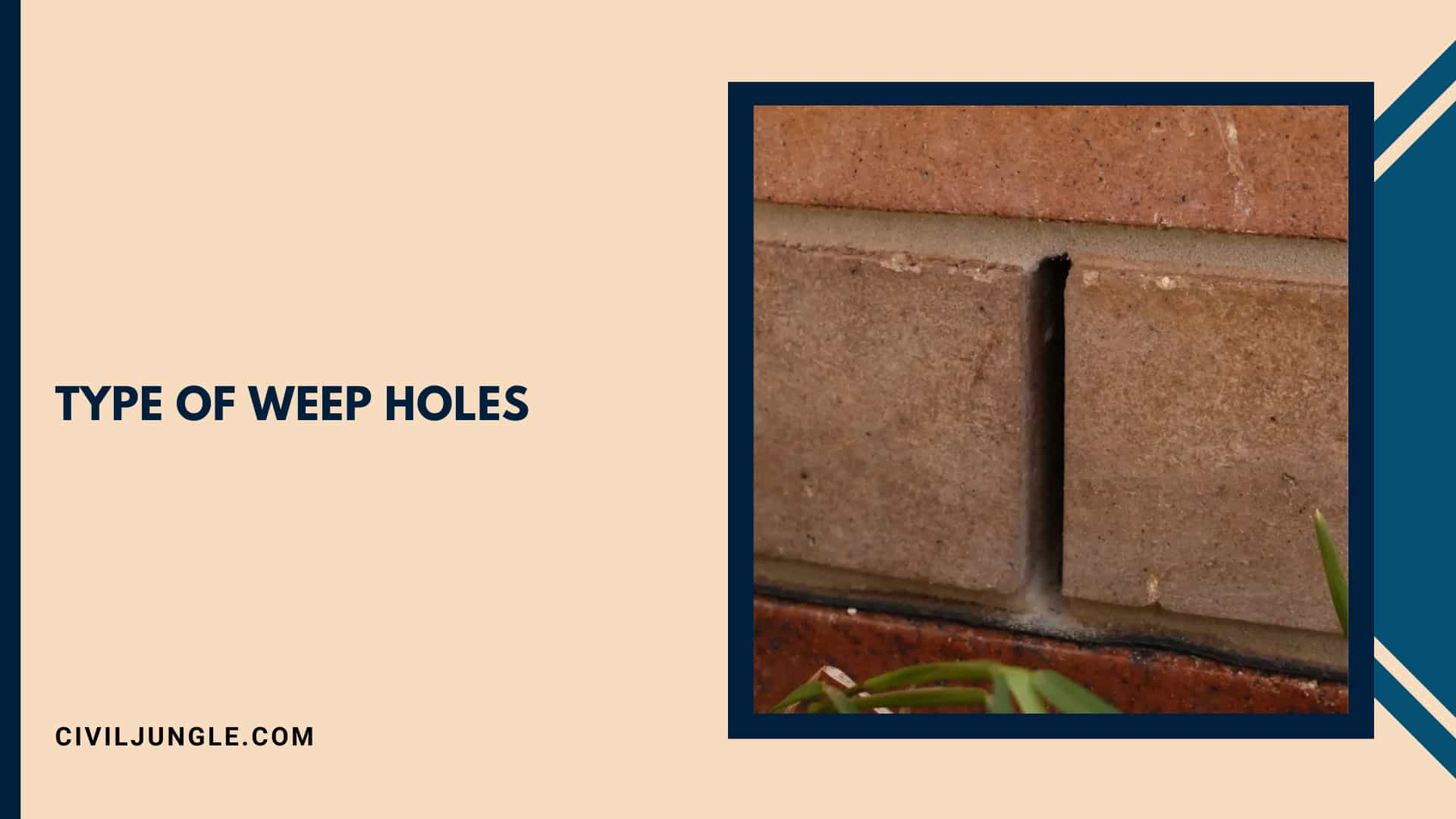What Are Weep Holes?
Important Point
Holes are made in the compound walls, underground passages, retaining wall weep holes, wing walls, other underground structures, etc., for water drainage called weep holes.
A weep hole is a round or square opening of 0.1 mt dia that allows water to escape from the inside of the retaining wall or water to enter from the outside.
Weep holes are usually made in the lower part of the wall. Water leaks out due to weep holes and strengthens the construction.
Also Read:
Type of Weep Holes
Weep holes are classified as follows based on their uses
1. Open Head Joint Weep Holes
These types of holes are formed by removing the mortar from the joint between the bricks. These types of holes are formed at a distance of 21 inches from each other. Weep holes are made in the lower part of the brick wall.
2. Cotton Rope Wicking Weep Holes
These types of weep holes are made using a cotton thread up to 16 inches long. The cotton thread is inserted into the joint, and the other end of the thread is extended to the cavity wall.
The cotton absorbs the water behind the wall, and on the other hand, the cotton comes out through the warp. Usually, this process is slow. It takes longer to get out of the water
Also Read:
3. Tubes Weep Holes
Weep Holes of this type are made by fixing PVC pipes. This type of pipe is fixed at a distance of 10 feet from each other.
Placing of Weep Holes
If the water level is equal to the level of a structure, then water will not accumulate behind the wall. Whip holes are not necessary for this situation.
Similarly, Weep holes are required in such circumstances when the pressure of the actions on the water increases when the structure is made under a water table.
Purpose of Weep Holes
According to the principle of gravity, water always comes out of the lower point. For the same reason, holes are always provided for the masonry walls at the bottom of the walls.
In addition, weep holes are provided on the lower side of the door and window. By doing this, when it rains, the rainwater escapes through these holes.
Water enters the structure and damages the structure so that water is discharged to the outside of the structure through the weep hole function.
Weep holes reduce water pressure and protect the structure. The weep holes act as a gate that allows any moisture to drain through the opening.
Which comes from behind the wall through rainwater, capillary action, or leakage. Whip holes, thus installed in brick masonry, also serve as ventilators.
So that air circulation to the back of the wall can be done and protection from dampness. Which in turn increases the life of the building.
Foundation of Weep Holes
Weep holes, especially retaining wall drainage holes, are provided at the bottom of the retaining wall to reduce its uplift pressure and provide safety to the structure.
Weep holes are usually found in the compound wall of the outside. Weep holes can also be found in the walls of cavities and on windows and doors as needed.
They are done at short intervals to protect them from moisture. Weep holes are kept at a distance of 450 mm from each other in the outer compound wall.
In the language of engineering, weep holes provide relief from water pressure and hydrostatic pressure on the walls.
Also Read:
Windows of Weep Holes
You never know about weep holes. However, it is very important to take care of these small holes. It has small holes at the bottom edge of the window frames that make the whip holes act as a gutter system for your windows.
It cannot serve this important task if it is blocked by paint and debris. So water seeps into the wood, and the wood starts to rot from the water.
The following measures should be taken to avoid the above repairs
- Weep holes should be inspected at least once a year before the start of the rainy season.
- If they are full or closed, they should be opened with a screwdriver, brush, or toothpick.
- Leaves accumulated on the windowsill, and dirt should be removed.
Advantage of Weep Holes
- Placing weep holes in the outside compound wall can easily get water out.
- Placing weep holes in the compound wall can reduce water and air pressure.
- Placing weep holes increases the life of the structure.
- Placing weep holes in the windows allows rainwater to flow out and protect the furniture.
Disadvantage of Weep Holes
- The only disadvantage of weep holes is that they have to be inspected periodically as the weep holes get filled up quickly due to their small size.
- Mortar goes into these holes when the holes make a weep hole in the brick masonry. As a result, mortar is also fixed and this waste is fixed with mortar and partially or completely closes the weep holes.
- Rats and other insects get inside through these weep holes.
- Mesh has to be provided to prevent rats and other insects.
- The net, which is fixed to prevent rats and other organisms from entering the weep holes, closes the weep holes by trapping debris in the weep holes.
Like this post? Share it with your friends!
Suggested Read –




Leave a Reply